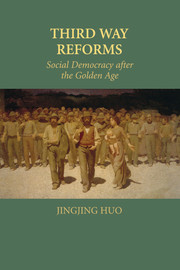Book contents
- Frontmatter
- Contents
- Tables and Figures
- Acknowledgments
- 1 Introduction
- 2 Theorizing the Third Way
- 3 Constraints on Action: Institutions and Ideas
- 4 Prelude to the Third Way: The Unemployment Problem and Earlier Responses
- 5 Expansion in Active Protection
- 6 Restructuring Passive Protection
- 7 Economic and Corporatist Contexts for the Third Way
- 8 Conclusion: Theories of Possibilities
- References
- Index
4 - Prelude to the Third Way: The Unemployment Problem and Earlier Responses
Published online by Cambridge University Press: 20 February 2010
- Frontmatter
- Contents
- Tables and Figures
- Acknowledgments
- 1 Introduction
- 2 Theorizing the Third Way
- 3 Constraints on Action: Institutions and Ideas
- 4 Prelude to the Third Way: The Unemployment Problem and Earlier Responses
- 5 Expansion in Active Protection
- 6 Restructuring Passive Protection
- 7 Economic and Corporatist Contexts for the Third Way
- 8 Conclusion: Theories of Possibilities
- References
- Index
Summary
To provide a historical context for third way reforms, this chapter outlines the developments in key economic and social problems being increasingly confronted by the nine countries after the Golden Age, and how pre-third way governments attempted to respond to these difficulties. Amid all these interconnected problems of economic and social policies, rapidly increasing unemployment was especially relevant for third way reforms. As Figure 4.1 indicates, this is a universal and clear-cut trend across all the nine cases covered in the book. The unemployment problem not only directly shaped strategies of active and passive protection but also required corresponding adjustments in macroeconomic and incomes policies. For the third way ideology, unemployment posed one especially serious threat, in labor market and social exclusion due to long-term unemployment. The exclusion of the worst-off contradicts the principles of both solidarity and prioritarianism (protecting the weakest).
Unfortunately, historical data are relatively scarce for long-term unemployment, only sufficient for a decade span of nine-country comparison. To better discern the pattern of long-term unemployment, I have graphed the nine countries in two separate groups. In the low group (Figure 4.2), the share of unemployment one year or longer out of total unemployment ranges from 14% to 29%. In the high group (Figure 4.3), it ranges from 40% to 50%. Clearly, for the high group, long-term unemployment remained about as high at the end as the beginning. For the low group, it increased consistently through time, drawing these countries closer to the high group. In short, persistent labor market exclusion became a problem common to all countries by the eve of third way reforms.
- Type
- Chapter
- Information
- Third Way ReformsSocial Democracy After the Golden Age, pp. 84 - 100Publisher: Cambridge University PressPrint publication year: 2009

